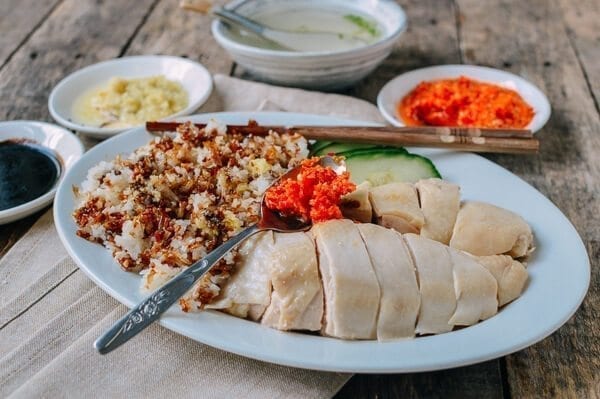Hainanese Chicken Rice
4.9
(20)
Your folders
Your folders
Prep Time: 5 minutes
Cook Time: 150 minutes
Total: 155 minutes
Servings: 6
Author : Judy

Ingredients
Export 19 ingredients for grocery delivery
Instructions
Step 1
Wash the chicken clean and remember to set aside the piece of chicken fat at the back cavity. Transfer the chicken to a plate and pat dry with a paper towel. Lightly rub the chicken with the salt. This will give the chicken skin a nice sheen. Set it aside.
Step 2
Bring the water, along with the ginger and scallions, to a boil in a large stockpot. Before adding the chicken to the pot, rinse the chicken under running water to wash away the salt. Carefully lower the chicken into the boiling water, positioning the chicken breast-side up. Now is a good time to adjust the water level so the chicken breast just pokes above the water (so you aren’t left with dry white meat).
Step 3
Once the water boils, carefully lift the chicken out of the water to pour out the colder water that is trapped in the cavity. Carefully lower the chicken back into the pot. Bring the water to a boil again, and cover the lid. Turn off the heat, and leave the pot covered on the stove for 45-50 minutes (set a timer). To check if the chicken is done, stick a toothpick into the thickest part of the drumstick. If the juices run clear, it’s cooked through.
Step 4
When the 45-minute timer (for the chicken) is almost up, prepare a large ice bath. Once the chicken is cooked, carefully lift the chicken out of the pot, drain the water from the cavity and lower it into the ice bath. Take care not to break the skin. After 15 minutes in the ice bath, the chicken should be cooled completely, drain and cover with clear plastic until ready to cut and serve. The ice bath stops the cooking process, locks in the juices, and gives the chicken skin better texture.
Step 5
While the chicken is cooling, make the rice. Heat a wok over medium heat. Add the chicken fat and render for about a minute. Stir in the minced garlic and fry briefly, making sure it doesn’t burn.
Step 6
Add the uncooked rice. Stir continuously for about two minutes.
Step 7
Turn off the heat. Scoop the rice into your rice cooker and add the appropriate amount of chicken stock (instead of the usual water. This amount may vary depending on your rice cooker) and salt. Close the lid and press START.
Step 8
If you don’t have a rice cooker, you can follow these steps. When you wash your rice, let it soak for an additional 20 minutes. Then drain the rice and follow the same steps above, but instead of transferring the rice mixture to your rice cooker, transfer it to a medium/large pot. Add 3 cups of chicken stock and the salt, giving it a quick stir. Cover the pot and bring to a boil. Once it boils, immediately turn down the heat to the lowest setting. Let the rice simmer and cook (covered) for 10-15 minutes until the rice is done. It’s not quite as foolproof as the rice cooker, but you should get a very similar result. Just be sure to keep an eye on it; burnt rice is no fun.
Step 9
While the rice is cooking, let’s prepare the three signature dipping sauces. You can also start preparing these sauces while the chicken is cooking in the pot.
Step 10
Grind the ginger and garlic in a food processor until a paste forms. Heat the oil in a small pot or saucepan. Gently fry the ginger and garlic until aromatic and just lightly caramelized. You want it to be just cooked so that it no longer has that spicy raw flavor of uncooked ginger and garlic. Add salt to taste and transfer to a sauce dish.
Step 11
Heat the water and sugar in a small saucepan over medium heat. Stir constantly until the sugar dissolves and the liquid thickens into a simple syrup. Add the dark soy sauce, stirring to combine. Transfer to a sauce dish.
Step 12
Grind the chilies, ginger, and garlic in a food processor until finely chopped. You will probably have to scrape down the sides of the food processor 1-2 times to ensure everything is ground up evenly. Add the sesame oil, salt, sugar, lime juice, and vinegar to the food processor. Pulse 2-3 times to combine.
Step 13
Transfer to a small bowl and add chicken broth (what you used to boil the chicken) 1 tablespoon at a time until a saucy consistency is achieved. This is really about your preference too; if you like a thicker paste, add less broth. The broth also helps the sauce come together and adds additional chicken flavor!